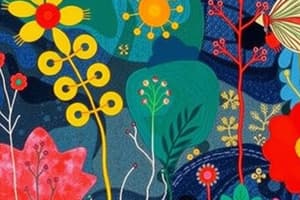Podcast
Questions and Answers
What process do plants use to make their food?
What process do plants use to make their food?
- Digestion
- Transpiration
- Photosynthesis (correct)
- Respiration
Which of the following statements correctly describes living things?
Which of the following statements correctly describes living things?
- Plants do not require air to grow.
- Living things can survive without food and water.
- Living things grow and reproduce. (correct)
- Animals do not respond to their environment.
Which of the following is NOT a characteristic of mammals?
Which of the following is NOT a characteristic of mammals?
- They have fur or hair.
- They often give live birth.
- They feed their young with milk.
- They can lay eggs. (correct)
What are common examples of non-living things?
What are common examples of non-living things?
Which human body system is responsible for pumping blood?
Which human body system is responsible for pumping blood?
How long does it take for the Earth to orbit around the Sun?
How long does it take for the Earth to orbit around the Sun?
What are the states of matter?
What are the states of matter?
Which type of energy is derived from the sun?
Which type of energy is derived from the sun?
Which of the following are conditions included in weather?
Which of the following are conditions included in weather?
What type of simple machine would you use to lift a heavy object?
What type of simple machine would you use to lift a heavy object?
Flashcards are hidden until you start studying
Study Notes
Basic Science Facts
-
Living Things
- All living things need food, water, and air.
- Animals and plants are living things.
- Living things grow, reproduce, and respond to their environment.
-
Non-Living Things
- Non-living things do not need food, water, or air.
- Examples include rocks, water, and toys.
-
Plants
- Plants have roots, stems, and leaves.
- They make their food using sunlight in a process called photosynthesis.
- Common plants include flowers, trees, and grasses.
-
Animals
- Animals can be divided into two groups: mammals and non-mammals.
- Mammals have fur or hair and often give live birth.
- Non-mammal examples: birds (feathers), fish (scales), reptiles (cold-blooded).
-
The Human Body
- The human body has different systems (e.g., skeletal, muscular, digestive).
- Major senses: sight, hearing, taste, touch, and smell.
- The heart pumps blood; lungs help us breathe.
-
Earth and Space
- The Earth is one of the planets in our solar system.
- It takes 365 days for the Earth to orbit around the Sun.
- The Moon orbits the Earth and affects tides in the ocean.
-
Weather
- Weather includes conditions like rain, sun, snow, and wind.
- Temperature can be hot, warm, cool, or cold.
- Seasons: spring, summer, autumn (fall), and winter.
-
Simple Machines
- Types include levers, pulleys, wheels and axles, inclined planes, screws, and wedges.
- Simple machines help make work easier.
-
Matter
- Matter is anything that takes up space and has mass.
- States of matter: solid, liquid, and gas.
- Water is unique as it can exist in all three states.
-
Energy
- Energy is needed to do work or cause changes.
- Types of energy: sunlight, heat, electrical, and mechanical.
-
Light and Sound
- Light travels in straight lines and can be reflected or refracted.
- Sound is produced by vibrations and travels through air, water, and solids.
These facts provide a foundational understanding of basic scientific concepts suitable for a class 2 student.
Living Things
- All living things have basic needs: food, water, and air.
- Animals and plants are both living.
- Living things grow, reproduce, and react to their surroundings.
Non-Living Things
- Rocks, water, and toys are examples of things that are not alive.
- Non-living things do not need food, water, or air.
Plants
- Plants are made of roots, stems, and leaves.
- Plants make their own food using sunlight through photosynthesis.
- Common plants include flowers, trees, and grass.
Animals
- Animals are divided into mammals and non-mammals.
- Mammals have fur or hair, and usually give birth to live young.
- Examples of non-mammals include birds (feathers), fish (scales), and reptiles (cold-blooded).
The Human Body
- The human body is made up of different systems, like the skeletal, muscular, and digestive systems.
- We have five main senses: sight, hearing, taste, touch, and smell.
- The heart pumps blood, and the lungs help us breathe.
Earth and Space
- Earth is a planet in our solar system.
- It takes Earth 365 days to orbit the Sun.
- The Moon orbits Earth and causes tides in the ocean.
Weather
- Weather includes conditions like rain, sunshine, snow, and wind.
- Temperatures can be hot, warm, cool, or cold.
- We have four seasons: spring, summer, autumn (fall), and winter.
Simple Machines
- Simple machines make tasks easier.
- Common types include levers, pulleys, wheels and axles, inclined planes, screws, and wedges.
Matter
- Matter is anything that takes up space (volume) and has weight (mass).
- Matter exists in three states: solid, liquid, and gas.
- Water is unique because it can be found in all three states of matter.
Energy
- Energy is needed to do work or cause changes.
- Types of energy include sunlight, heat, electrical, and mechanical energy.
Light and Sound
- Light travels in straight lines and can be reflected or refracted.
- Sound is created by vibrations and travels through air, water, and solid objects.
Studying That Suits You
Use AI to generate personalized quizzes and flashcards to suit your learning preferences.



